Receding Horizon Control
Mar´ıa M. Seron
September 2004
Centre for Complex Dynamic
Systems and Control
�
The Receding Horizon Control Principle
Fixedhorizonoptimisationleads to a control sequence
fui; : : : ; ui+N1g, which begins at the current time i and ends at
some future time i + N 1.
This fixed horizon solution suffers from two potential drawbacks:
(i) Something unexpected may happen to the system at some
time over the future interval [i; i + N 1] that was not predicted
by (or included in) the model. This would render the fixed
control choices fui; : : : ; ui+N1g obsolete.
(ii) As one approaches the final time i + N 1, the control law
typically “gives up trying” since there is too little time to go to
achieve anything useful in terms of objective function
reduction.
Centre for Complex Dynamic
Systems and Control
�
The Receding Horizon Control Principle
The above two problems are addressed by the idea of receding
horizonoptimisation.
This idea can be summarised as follows:
(i) At time i and for the current state xi, solve an optimal control
problem over a fixed future interval, say [i; i + N 1], taking
into account the currentand futureconstraints.
(ii) Apply only the first step in the resulting optimal control
sequence.
(iii) Measure the state reached at time i + 1.
(iv) Repeat the fixed horizon optimisation at time i + 1 over the
future interval [i + 1; i + N], starting from the (now) current
state xi+1.
Centre for Complex Dynamic
Systems and Control
�
The Receding Horizon Control Principle
In the absence of disturbances, the state measured at step (iii) will
be the same as that predicted by the model.
Nonetheless, it seems prudent to use the measuredstate rather
than the predicted state just to be sure.
The above description assumes that the state is measured at
time i + 1.
In practice, one would use some form of observer to estimate xi+1
based on the available data.
More will be said about the use of observers in the next lecture.
For the moment, we will assume that the full state vector is
measured and we will ignore the impact of disturbances.
Centre for Complex Dynamic
Systems and Control
�
The Receding Horizon Control Principle
If the model and objective function are time invariant, then the
same input ui will result whenever the state takes the same value.
That is, the receding horizon optimisation strategy is really a
particular time-invariantstatefeedbackcontrollaw:
uk
xk+1 = f(xk; uk)
xk
PSfrag replacements
RHC
In particular, we can set i = 0 in the formulation of the open loop
control problem.
Centre for Complex Dynamic
Systems and Control
�
The Receding Horizon Control Principle
More precisely, at the current time, and for the current state x, we
solve:
PN(x) :
for k = 0; : : : ; N 1;
Vopt
N (x) , min VN(fxkg; fukg);
subject to:
xk+1 = f(xk; uk)
x0 = x;
uk 2 U for k = 0; : : : ; N 1;
xk 2 X for k = 0; : : : ; N;
xN 2 Xf X;
where
VN(fxkg; fukg) , F(xN) +
N1
X
k=0
L(xk; uk):
(1)
(2)
(3)
(4)
(5)
(6)
(7)
Centre for Complex Dynamic
Systems and Control
�
The Receding Horizon Control Principle
The sets U Rm, X Rn, and Xf Rn are the input, state and
terminal constraint set, respectively.
All sequences fukg = fu0; : : : ; uN1g and fxkg = fx0; : : : ; xNg
satisfying the constraints (2)–(6) are called feasible sequences.
A pair of feasible sequences fu0; : : : ; uN1g and fx0; : : : ; xNg
constitute a feasiblesolution.
The functions F and L in the objective function (7) are the terminal
stateweightingand the per-stageweighting, respectively.
Centre for Complex Dynamic
Systems and Control
�
The Receding Horizon Control Principle
In the sequel we make the following assumptions:
f, F and L are continuous functions of their arguments;
U Rm is a compact set, X Rn and Xf Rn are closed sets;
there exists a feasible solution to problem (1)–(7).
Because N is finite, these assumptions are sufficient to ensure the
existence of a minimum by Weierstrass’ theorem.
Centre for Complex Dynamic
Systems and Control
�
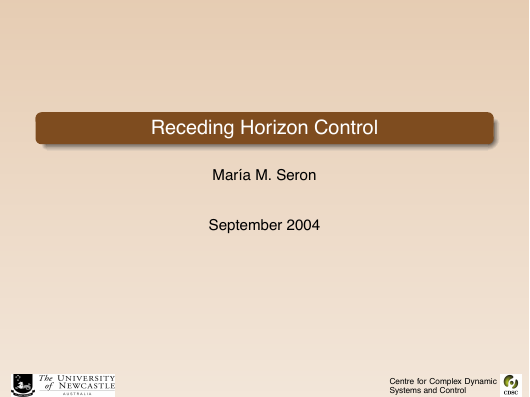
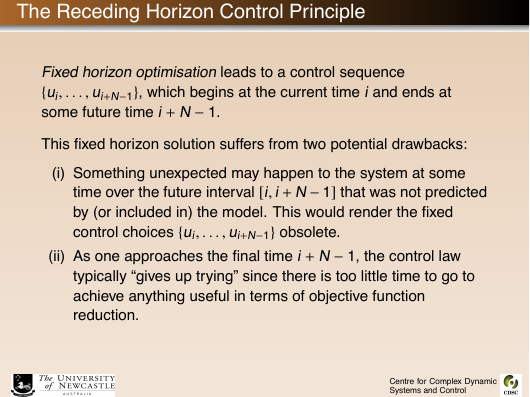
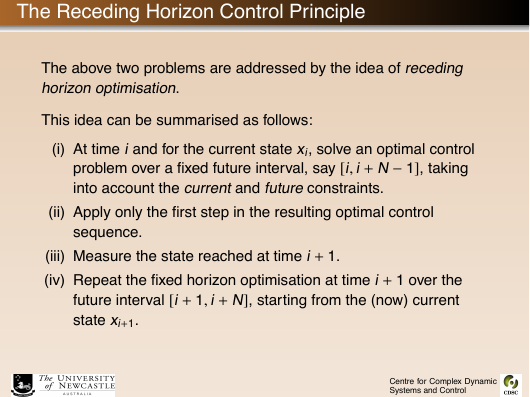
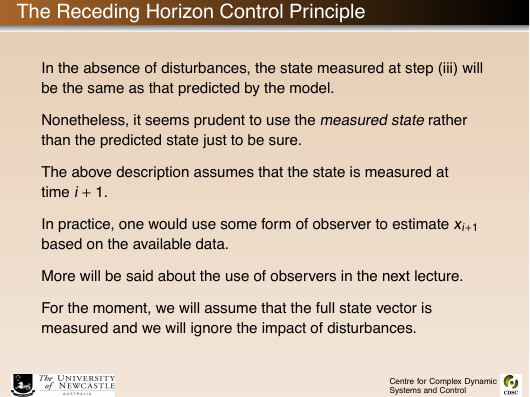
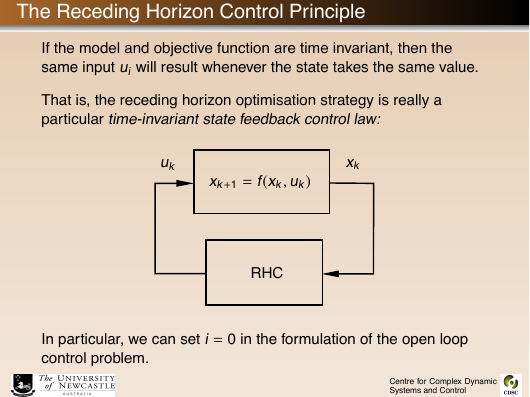
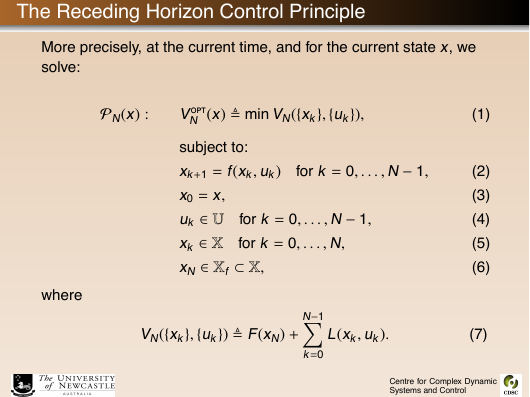
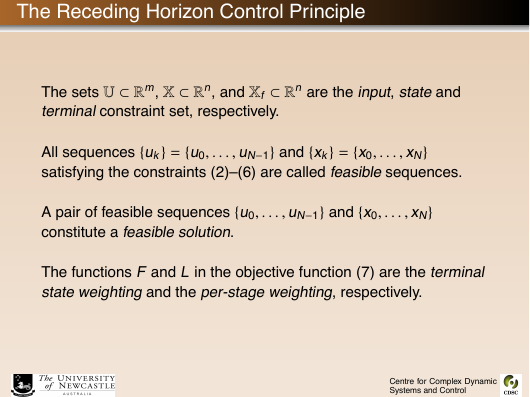
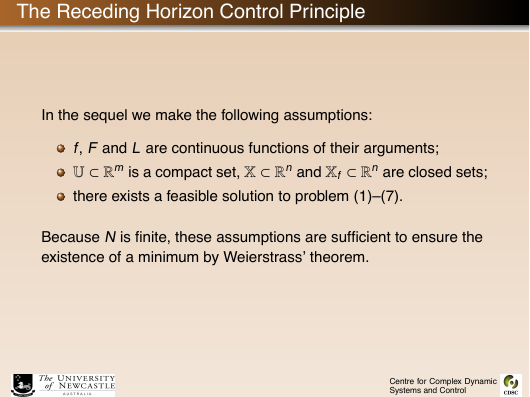








 2023年江西萍乡中考道德与法治真题及答案.doc
2023年江西萍乡中考道德与法治真题及答案.doc 2012年重庆南川中考生物真题及答案.doc
2012年重庆南川中考生物真题及答案.doc 2013年江西师范大学地理学综合及文艺理论基础考研真题.doc
2013年江西师范大学地理学综合及文艺理论基础考研真题.doc 2020年四川甘孜小升初语文真题及答案I卷.doc
2020年四川甘孜小升初语文真题及答案I卷.doc 2020年注册岩土工程师专业基础考试真题及答案.doc
2020年注册岩土工程师专业基础考试真题及答案.doc 2023-2024学年福建省厦门市九年级上学期数学月考试题及答案.doc
2023-2024学年福建省厦门市九年级上学期数学月考试题及答案.doc 2021-2022学年辽宁省沈阳市大东区九年级上学期语文期末试题及答案.doc
2021-2022学年辽宁省沈阳市大东区九年级上学期语文期末试题及答案.doc 2022-2023学年北京东城区初三第一学期物理期末试卷及答案.doc
2022-2023学年北京东城区初三第一学期物理期末试卷及答案.doc 2018上半年江西教师资格初中地理学科知识与教学能力真题及答案.doc
2018上半年江西教师资格初中地理学科知识与教学能力真题及答案.doc 2012年河北国家公务员申论考试真题及答案-省级.doc
2012年河北国家公务员申论考试真题及答案-省级.doc 2020-2021学年江苏省扬州市江都区邵樊片九年级上学期数学第一次质量检测试题及答案.doc
2020-2021学年江苏省扬州市江都区邵樊片九年级上学期数学第一次质量检测试题及答案.doc 2022下半年黑龙江教师资格证中学综合素质真题及答案.doc
2022下半年黑龙江教师资格证中学综合素质真题及答案.doc